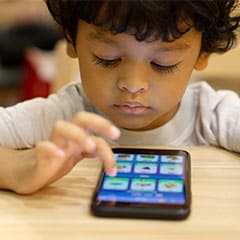Time online
Home / Parents / The Big Issue / Time online
Time online
Help your child achieve a healthy balance in their online and offline activities.
This is for parents and carers, covering online time in general. Parents can also read information about online gaming.

How much is too much?
There is no magic figure. The right amount of screen time depends on your child’s age and maturity, the kind of content they are consuming, their learning needs and your family routine.
Signs to watch for
- Less interest in social activities like meeting friends or playing sport
- Not doing so well at school
- Tiredness, sleep disturbance, headaches, eye strain
- Changes in eating patterns
- Reduced personal hygiene
- Obsession with particular websites or games
- Extreme anger when being asked to take a break from online activity
- Appearing anxious or irritable when away from the computer
- Becoming withdrawn from friends and family
What to do if you are concerned
- Ask questions and listen — behavioural changes can be normal, but try to find out why.
- Talk about how much time they spend online and what they could be missing out on.
- Talking to your child’s school may reveal academic or social issues, and the school may be able to support.
Help your child manage their online time
Stay engaged and encourage balance
- Keep an eye on the games, apps and devices your child uses. Help them be aware of time spent across different activities.
- Include positive things outside the online world in your conversations, such as what they love in life or careers they’re interested in.
- Join in. Play games together as a family, or explore some joint online projects.
- Avoid using online time as a punishment as this may inflate its importance to children.
Create a plan
- Build a family plan for leisure and screen time (including TV) alongside offline activities.
- Agree rules such as which websites can be visited and when homework/chores are complete before screen time.
- Use small daily reductions or a “15-minutes to switch off” warning to help transition to a more balanced routine.
Reducing your own screen time also sets a positive example
- Consider a signed family online safety agreement.
- Have clear consequences for not sticking to the agreement and follow through consistently.
Use the available technology
- Use parental controls to monitor and limit what your child sees and does online — be open about why and how you use these tools.
- Use apps/software to measure online time and set limits on device use or internet access.
Set boundaries for digital device use in your home
Device-free zones and times can help you manage screen time. For example, your family plan could include rules like:
- No devices in the bedroom for younger children
- All screens off in bedrooms after a certain time for older children
- All screens off at least one hour before planned bedtime
- All family members switch off at dinner time
- Devices charged overnight in a place your child cannot access
This material has been adapted with permission from the Australian Government eSafety Commissioner. Permission to adapt content does not constitute endorsement of material by the eSafety Commissioner.
